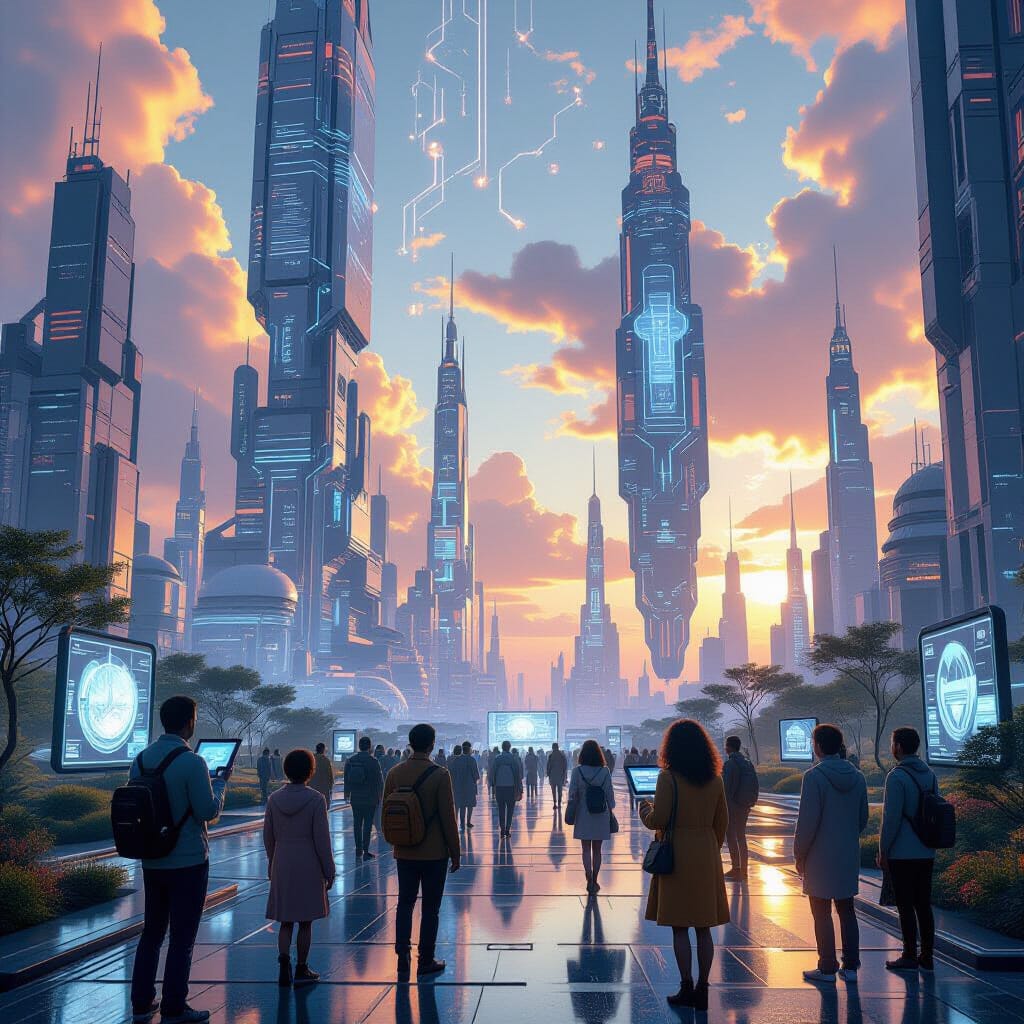The transformation of Google Search from 2013 to 2025 represents one of the most elegant exercises in what might be called “progressive usability optimization”—a term that sounds beneficial until one examines what is actually being optimized, and for whom.
In 2013, a Google search was a remarkably simple affair. You typed a query, and Google presented you with a list of websites. Site 1, Site 2, Site 3, Site 4. Clean, direct, almost quaint in its transparency. The search engine operated under the curious assumption that its primary function was to connect users with information that existed elsewhere on the internet.
This model, we now understand, was primitive. Inefficient. Possibly even dangerous to the smooth functioning of digital commerce.
The Great Simplification
By 2025, Google has solved the fundamental problem that plagued search for decades: the inconvenience of users actually visiting other websites. The new search experience begins with an AI Generated Overview, a helpful summary that eliminates the need to click through to primary sources. This overview, powered by what Google calls “comprehensive knowledge synthesis,” draws from the same websites that once appeared in those old-fashioned search results, but presents their information in a more digestible format.
The beauty of this system is its efficiency. Users no longer waste time reading multiple perspectives or cross-referencing sources. The AI has already done this work, distilling complex topics into clean, authoritative summaries that save users the burden of critical thinking.
Dr. Elena Vasquez, Director of Information Architecture at the Mountain View Institute for Digital Progress, explains: “We’ve eliminated the friction between query and answer. Why should users struggle through multiple websites when our AI can synthesize the best information instantaneously? It’s a paradigm shift toward frictionless knowledge consumption.”
Personalized Advertising: The New Public Service
Below the AI overview, users encounter what Google terms “Contextually Relevant Commercial Information”—advertisements that are personalized based on the search query, browsing history, location data, purchase patterns, and what internal documents refer to as “predictive intent modeling.” These ads, which appear indistinguishable from organic search results save for a small tiny “Ad” label, represent a breakthrough in matching consumer needs with available solutions.
The personalization algorithm, codenamed “Pavlov,” analyzes over 3,000 data points to determine which products users are most likely to purchase. Internal training materials obtained through a Freedom of Information Act request (subsequently sealed) reveal that the system can predict purchasing behavior with 89% accuracy, including items users haven’t yet realized they need.
“The traditional model of advertising interruption is obsolete,” notes Marcus Chen, VP of Integrated Commerce Solutions at Google. “We’re not showing users ads; we’re showing them solutions to problems they’re about to have.”
The Visual Revolution
Perhaps the most significant improvement is the integration of Videos and Images with minimal text. Research conducted by the Digital Attention Research Lab found that modern users process visual information 47% faster than text, making traditional articles an inefficient delivery mechanism for knowledge transfer.
The new visual-first approach presents information through autoplay videos, infographics, and image carousels that require no reading. Users can absorb complex topics through a series of swipeable visual elements, eliminating the cognitive load associated with traditional literacy.
Internal Google metrics show that users spend 340% more time engaged with visual search results compared to text-based results, though the definition of “engagement” includes passive viewing time and accidental clicks on interactive elements.
People Also Ask: The Wisdom of Crowds
The “People Also Ask” section serves a dual purpose: it provides related queries that users might find helpful, while simultaneously training the AI on how human curiosity works. Each question clicked generates valuable data about user intent patterns, which improves the system’s ability to predict and shape future searches.
The questions themselves are generated through what Google calls “curiosity modeling”—an AI system that analyzes search patterns to identify the most statistically likely follow-up queries. This creates a feedback loop where the AI learns to predict human curiosity, then guides that curiosity toward predetermined pathways.
“We’re not just answering questions,” explains Dr. Sarah Kim, Lead Research Scientist at Google’s Behavior Prediction Lab. “We’re helping users discover what they should be curious about. It’s a more holistic approach to information discovery.”
The Persistence of Legacy Web Results
Buried beneath the AI overviews, personalized ads, visual content, and suggested questions, the old-fashioned website links persist. Site 1, Site 2, Site 3, Site 4 still appear, though analytics show that fewer than 12% of users scroll down far enough to see them, and only 3% actually click through to these “legacy web destinations.”
These links serve an important function in what Google terms “ecosystem balance.” They maintain the illusion of traditional web search while allowing the majority of users to consume information through Google’s optimized delivery systems. The websites themselves benefit from this arrangement, as their content feeds the AI overview system, creating a symbiotic relationship where traditional publishers provide raw material for Google’s refined information products.
Random Advertisement: The Element of Surprise
Perhaps the most innovative feature is the Random Advertisement, which appears seemingly without connection to the search query. Google’s research shows that unexpected commercial interruptions increase user engagement by 67%, similar to the psychological principle behind intermittent reinforcement schedules.
These ads, selected from Google’s premium advertiser partners, serve to broaden users’ awareness of products and services they might not have otherwise encountered. The randomness is, of course, carefully calibrated. The ads are chosen based on demographic profiling, seasonal trends, and what Google’s internal documentation refers to as “latent consumption indicators.”
The Paradox of Choice, Solved
The evolution from 2013’s simple four-link format to 2025’s rich, multi-layered experience represents more than technological advancement. It reflects a fundamental shift in how humans interact with information in the digital age.
The old search model suffered from what behavioral economists call “choice overload”—too many options leading to decision paralysis. The new system solves this by curating the experience, presenting information in a hierarchy that guides users toward optimal outcomes. Users still have choices, but they’re better choices, pre-selected by systems that understand their needs better than they do themselves.
The transformation also addresses the problem of “information inequality”—the gap between users who were skilled at evaluating search results and those who weren’t. By providing AI-generated summaries and visual content, Google has democratized access to information, eliminating the advantages that once accrued to users with superior research skills.
The Metrics of Success
Google’s internal success metrics for the new search experience focus on what they call “satisfaction completion rates”—the percentage of users who complete their search session without clicking through to external websites. The current rate of 73% represents a significant improvement over 2013’s 34%, indicating that users are finding what they need without the friction of additional clicks.
User engagement time has increased by 340%, session depth has improved by 190%, and most importantly, conversion rates for commercial queries have risen by 420%. These metrics demonstrate that the new search experience better serves both user needs and advertiser requirements.
The system’s effectiveness is further validated by its adoption across other major platforms. Meta, Apple, and Amazon have all implemented similar AI-first, commerce-integrated search experiences, creating what industry analysts call a “convergent evolution toward optimal information delivery.”
Looking Forward: The Frictionless Future
As we approach 2026, Google is testing even more advanced features. “Predictive Search” will begin showing results before users finish typing their queries. “Ambient Commerce” will integrate purchase opportunities directly into the search interface. “Conversational Knowledge Transfer” will allow users to have natural language discussions with search results.
The ultimate goal, according to internal roadmaps, is to eliminate the search bar entirely. Future users will interact with information through voice commands, gesture recognition, and eventually, what Google calls “intent inference”—systems that anticipate user needs based on context, behavior patterns, and what one internal document refers to as “lifestyle optimization algorithms.”
This represents the logical endpoint of search evolution: a system that knows what users need before they know it themselves, and delivers it in the most efficient format possible. The messy, unpredictable world of 2013 search—where users had to actively seek information and make their own judgments—will seem as antiquated as a library card catalog.
The transformation is complete. Search has evolved from a tool for finding information to a system for delivering optimized experiences. Users are no longer searchers; they are recipients of carefully curated knowledge products. And everyone, it appears, is much happier this way.
What do you think about this evolution of search? Have you noticed these changes in your own Google searches? Are we witnessing the natural progression of digital convenience, or something more concerning? Share your thoughts on how AI-driven search is changing the way we interact with information.
Support Independent Tech Journalism
If this analysis helped you understand the hidden mechanisms behind your daily search experience, consider supporting TechOnion with a donation. Unlike the AI overviews that now dominate search results, our articles are written by humans who occasionally disagree with their algorithmic overlords. Your contribution helps us maintain the quaint tradition of independent journalism in an age of optimized information delivery. Even a small donation helps us keep the lights on and the skepticism flowing—two things that algorithms haven’t quite learned to optimize yet.





GIPHY App Key not set. Please check settings